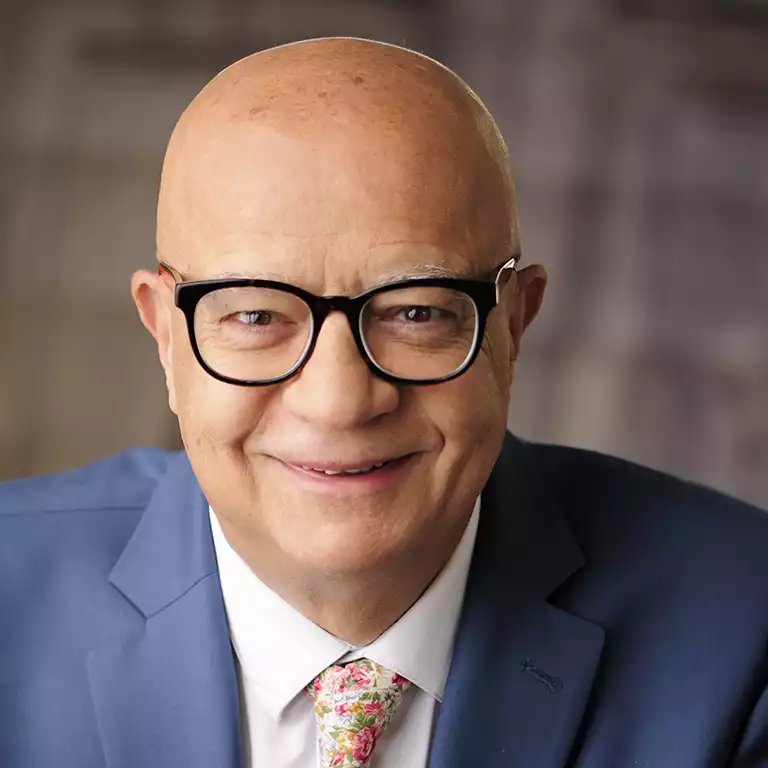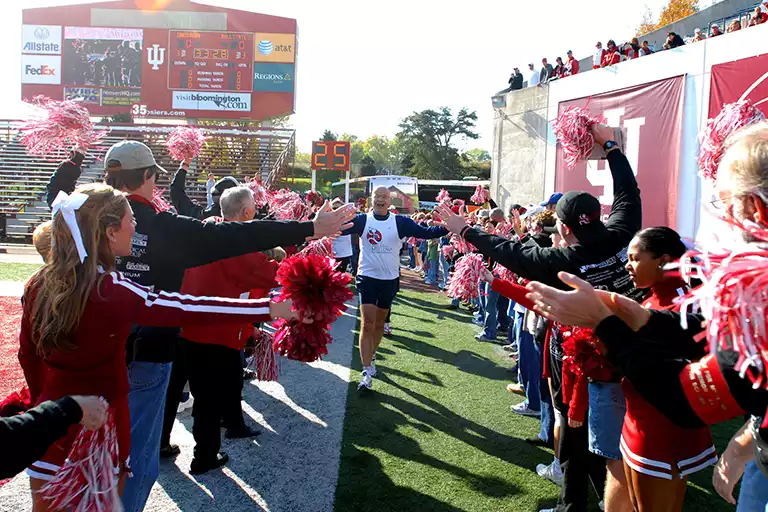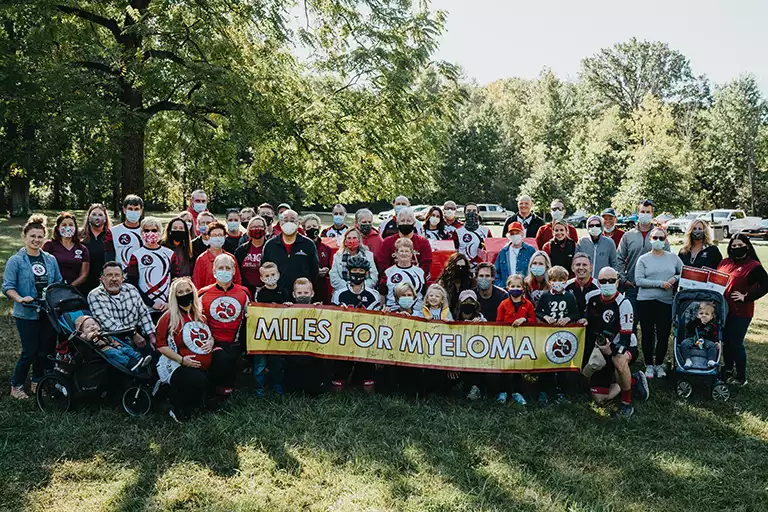Patients with multiple myeloma face significant challenges — both physically and emotionally. But those receiving treatment at IU are never facing these challenges alone. Instead, they have a formidable champion in Rafat Abonour, MD — a physician who not only provides impeccable care to his patients but who also becomes their constant cheerleader, trusted confidant, and valued friend. Nothing exemplifies this more than Miles for Myeloma — an annual event that Abonour, the Harry and Edith Gladstein Professor of Cancer Research, launched in 2005 to honor the resilience of his patients and to push research for multiple myeloma forward. Twenty years later, Miles for Myeloma is still going strong.
Q&A with Rafat Abonour, MD

Q. What drew you to working with patients who have multiple myeloma?
In addition to being fascinated by the science of multiple myeloma, it’s the relationships I build with my patients that makes the work I do so enjoyable and so rewarding. Unfortunately, there currently isn’t a cure for this disease, so patients stay with me for a long time. This gives me an opportunity to get to know them well and they become like family.
I enjoy learning about what makes my patients happy and what their aspirations are. When I see a patient fight and survive multiple myeloma while living life to the fullest, it’s quite inspiring. I love witnessing the humanity of these individuals which is evident in how they deal with such a devastating diagnosis, how they manage the burdens of the disease and the treatment of it, and how they still keep going every day as moms, dads, sons, daughters, co-workers, and all of the other roles they have.
Q. What’s the most challenging aspect of working with these patients?
I enjoy taking patients through the journey of treatment. However, some of the disease burden is really hard to overcome. With multiple myeloma, many patients experience chronic pain. But when we find ways to manage it so that a patient can get back to doing things that they loved doing before their diagnosis, that’s very rewarding. I would say that the most significant challenge is when I see patients who were diagnosed too late. These patients have come to me for a second opinion, and I wonder why the disease wasn’t recognized sooner.

Q. What’s the most rewarding aspect of working with patients who have multiple myeloma?
It’s witnessing the resilience of human beings. It’s in seeing how people face adversity, keep moving forward, and live a beautiful life despite having a horrible disease.
Q. The inaugural Miles for Myeloma took place in 2005. What was the spark that led you to the idea for this event?
I knew we needed to support our multiple myeloma program, so I asked myself, “What can we do? How can we increase awareness of the disease and raise funds to support our ongoing research?”
I was sitting with a group of my patients and we began trying to figure out an answer. At the time, I was really into running — including running marathons. One of my patients suggested that we do a 5k run. But there are already so many of those. We wanted to do something that would really stand out.
During the brainstorming process, I thought about how my patients come to me from all over the state for second opinions. So, I thought that instead of them coming to me, we could hold a multi-day event during which I’d run to all of their cities and towns. For the first Miles for Myeloma event in 2005, we decided to do a two-day event that would take us to Fort Wayne. Also, due to the distance and the limited amount of time we had, we ran one day and biked the other.
Q. Oct. 1, 2005, was the first day of the inaugural Miles for Myeloma. What was it like?
It was a beautiful day for our start. Patients, colleagues, friends, family and IUPUI Jaguar cheerleaders gave us an inspiring and joyful send-off. Our initial group consisted of nine riders, two of whom were patients with multiple myeloma.
Q. On Day 2 of that first Miles for Myeloma, you all transitioned from biking to running. How did that go?
I started out the run with two friends who are seasoned ultra-marathoners. They had helped me train for this event. It was very hot that day and about 20 miles into our run, the heat radiating off of the pavement began to take a toll on me. My legs began cramping, so I had to stop temporarily to be given intravenous fluids. Also, my blood pressure was running low and tests regarding my kidney function weren’t very good. But, with the help of my colleagues and the support of my patients, their families, and all of our other supporters, I was able to rejoin our team of runners — which had grown to around nine. Together, we ran to Fort Wayne Lutheran Hospital Heart Pavilion — being led by a police escort and being followed by our RV. There was a large group of supporters waiting for us. When I crossed the finish line, I felt as if I was winning the Boston Marathon!
This event reaffirmed my faith in the compassion of people. New friendships were formed and old ones were renewed. It was wonderful. And we set a high bar for future Miles for Myeloma events by raising $125,000 for multiple myeloma research.
Q. Miles for Myeloma has been held every year in one form or another since 2005. Where has it taken you around the state?
Well, as we’ve discussed, we went to Fort Wayne the first year. Subsequent years took us to places like Bloomington, Evansville and towns along the way. Every time we stopped, we’d talk with groups about why we were doing this. We would also have a patient or family member share their story. I loved it, and I loved the connection we made with others.
Because of the time and distance involved in Miles for Myeloma, we stopped having a day of running and biked both days instead. Just like in any cycling event, riders can get spread out. One year, a patient who was undergoing treatment was riding with us. He wasn’t able to keep up with the group. So, the other riders designated this guy as the leader and followed him instead of riding ahead. This event brings out the best of humanity.
Q. How did the pandemic impact Miles for Myeloma in 2020?
Riding together and enjoying a celebration dinner afterward were out of the question. But our very creative team of patients, providers, family members and volunteers found a way for Miles for Myeloma to happen despite the pandemic.
We started an online campaign encouraging anyone to cycle, run, and/or walk, logging their miles in honor of myeloma patients. Participation in this challenge was tremendous, with thousands of miles being logged and funds being raised. Instead of an in-person dinner at the conclusion of the event, we held a live webinar during which we answered questions and highlighted advancements in multiple myeloma research and treatment.

Q. Miles for Myeloma has taken several different forms throughout the past 19 years as result of health concerns, logistical matters, and — of course — a global pandemic. But it’s still going. What does it look like today?
I promised patients that as long as multiple myeloma is an incurable disease, Miles for Myeloma will continue. Currently, the event involves participants logging their miles individually over a two-day period. At the end, we hold an in-person event — such as seminars, dinners or brunches. The event is held at different venues throughout Indianapolis and is attended by 300 people. They can ask us questions, and we give an update on treatments. It’s a lot of fun.
Q. Coming up with the idea for Miles for Myeloma and bringing it to fruition demonstrates a significant dedication to philanthropy. What is it that drives you to find ways to help your patients — beyond just providing medical care?
When I first came to the United States in 1984, I had to take an exam to become a certified physician here. Before I could do that, though, I had to take a course. It cost $1,000, and I didn’t have the funds. At the time, I was working in a lab and, one day, another scientist who also worked there came up to me and handed me $1,000 for the course. I told him I couldn’t pay him back. But he told me not to worry about that. Instead, he told me to pay this kindness forward. And Miles for Myeloma is one way I try to do that.
Helping each other is very important. It’s how we move things forward — including research for multiple myeloma. While we do receive grants and other types of funding, it’s limited. Also, there are often specific parameters around how these resources must be used. However, with funds raised through philanthropic efforts — such as Miles for Myeloma —we have the freedom to think outside of the box and ask bigger questions.
Q. What do you want the legacy of Miles for Myeloma to be?
I want it to be about the resilience of people when they’re faced with adversity. This resilience translates to a better quality of life. And, when people join forces to face adversity together, better outcomes can be achieved.
There are a lot of things we have in common as human beings. With Miles for Myeloma, we’ve proven that we can share a common cause or mission and work together so beautifully. I wish this could be translated into how human beings interact with each other no matter where they are or what their differences might be.




